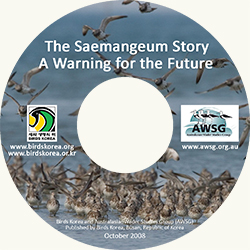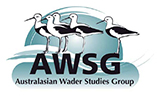|

|
|
 Users of the CD Users of the CDThis CD is for members of the public, Government officials, researchers, the media and anyone who is interested in learning more about the Saemangeum reclamation project and its impacts on people, wetlands and birds.
 Introduction to the CD Introduction to the CD
This CD is about:
Saemangeum is the name of the area which BirdLife International has described as the largest reclamation project in the world. In 1991, construction started on a 33-km long sea-wall across two estuaries on the west coast of the Republic of Korea (ROK) in the Yellow Sea, the Mangyeung and Dongjin estuaries. The area has become known as Saemangeum. Intertidal wetlands have been declining in the ROK at a rate of 1% every year for the past 30 years. The Saemangeum reclamation project has contributed greatly to this loss. The project was officially completed on the 21 April, 2006 and enclosed approximately 40,100 ha of tidal flats. The sea-wall effectively reduced the tidal range from 7 m to less than 1 m on most tides. This had a huge impact on the ecology of the entire area and impacted on the livelihoods of approximately 20,000 people supported by the tidal flats. Saemangeum was also the most important stopping site for migratory birds in the Yellow Sea when migrating north to breeding grounds as far away as Siberia and Alaska and south to winter in Australia and New Zealand. To determine the impact of the land reclamation on these shorebirds an intensive monitoring program was established by Birds Korea and the Australasian Wader Studies Group (AWSG). The Saemangeum Shorebird Monitoring Program (SSMP) was undertaken in April and May in 2006, 2007 and 2008. More than 70 people from twelve countries participated. The results confirm a massive decline in the number of shorebirds using Saemangeum. Shorebirds are not relocating to other nearby tidal flats in the region. Where these birds are is not clear. It is likely they have died. Two species in particular have suffered a major decline - the Great Knot and the Critically Endangered Spoon-billed Sandpiper. The data from the 2006 - 2008 SSMP report clearly show a decline of 137,000 shorebirds. A report was produced each year of the monitoring program. This CD summaries the methods and results of the SSMP and highlights the recommendations made in the 2006- 2008 report. These are the steps that can be taken to reduce the current impact on the Saemangeum and prevent other tidal flats suffering a similar fate. Action is needed now; for people, wetlands and birds.
 Menu MenuAbout this CD Saemangeum - An Introduction The SSMP What Can be Done? The Yellow Sea and its Role in the Flyway Additional material
 Contacts Contacts
Birds Korea - http://www.birdskorea.org
1009 Ho, 3 Dong, Samick Tower Apt., 148-22, Namcheon-Dong, Su-Young-Gu, Australasian Wader Studies Group - http://www.awsg.org.au C/- Birds Australia
 Birds Korea Birds Korea Birds Korea is dedicated to the conservation of birds and their habitats in Korea and the wider Yellow Sea Eco-region, working through research, education and public-awareness raising activities, consultation and collaboration, and well-focused advocacy.
Birds Korea is dedicated to the conservation of birds and their habitats in Korea and the wider Yellow Sea Eco-region, working through research, education and public-awareness raising activities, consultation and collaboration, and well-focused advocacy.
 Australasian Wader Studies Group (AWSG) Australasian Wader Studies Group (AWSG) The Australasian Wader Studies Group is a Special Interest Group of Birds Australia (Birdlife Partner in Australia). The AWSG aims to ensure the future of waders and their habitats in Australasia through research and conservation programs and to encourage and assist similar programs throughout the East Asian-Australasian Flyway.
The Australasian Wader Studies Group is a Special Interest Group of Birds Australia (Birdlife Partner in Australia). The AWSG aims to ensure the future of waders and their habitats in Australasia through research and conservation programs and to encourage and assist similar programs throughout the East Asian-Australasian Flyway.
 Acknowledgements AcknowledgementsThe images included on this CD are copyright by the owners and must not be copied for commercial purposes without express permission. We would like to thank the following people who have kindly provided images for this presentation:
 Useful Links Useful Links

Birds Korea and Australasian Wader Studies Group (AWSG). 2008.
The Saemangeum Shorebird Monitoring Program 2006-2008 Report, Presentations and Additional Information. Published by Birds Korea, Busan, Republic of Korea.
|